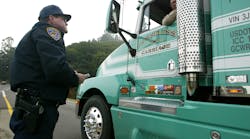By Joseph Evangelist, executive vice president, Transervice
Every driver knows he or she is supposed to complete the required Federal Motor Carrier Safety Administrations pre- and post-trip inspection. These inspections are designed to ensure trucks are in safe operating condition.
Even though drivers routinely perform these inspections, it doesn’t hurt to have a little refresher on exactly what’s involved.
FMCSA has a seven-point checklist for inspections. It includes the following.
- Vehicle overview: Check the truck’s general condition.
- Engine compartment: Check fluid levels including engine oil, coolant, transmission fluid. Check hoses, belts, wires, batteries and electrical connections.
- Inside the cab: Check all gauges and controls.
- Lights: Check low-beam headlights, four-way flashers and high-beam headlights.
- Walk-around exterior inspection: Start at the front left of the truck and continue to the front, right side, left rear, left side and coupling system.
- Signal lights: Make sure all signal lights are working properly.
- Brake system check: Make sure all brakes including parking brakes and service brakes work properly.
There are also some things you should do during transit. Within the first 50 miles of transit, inspect and adjust cargo and load-securing devices. After 50 miles, cargo must be re-examined when a driver makes a change of duty status or after the vehicle has been driven for three hours or 150 miles. This does not apply of you if you are driving a sealed vehicle and have been ordered not to open it.
Following a trip, you need to inspect the truck again and identify and report any defects. Check the following areas:
- Service brakes — including rear trailer brake connections
- Parking brake
- Steering mechanism
- Lighting devices and reflectors
- Tires
- Horn
- Windshield wipers
- Rear-view mirrors
- Coupling devices
- Wheels and rims
- Emergency equipment
When every driver completes both pre- and post-trip inspections, the roads are much safer for everyone. And remember, if you find a problem and repair it before the truck leaves the yard it won’t show up during a roadside inspection.
Editor's note: Joseph Evangelist is a seasoned transportation executive with domestic and international experience in sales, operations, mergers and acquisition with heavy emphasis on post-acquisition assimilation planning to maximize new growth and business combination opportunities. He joined Transervice in 2007 and currently serves as executive vice president with sales, operations and staff responsibilities.



